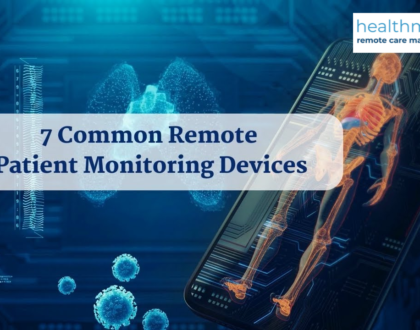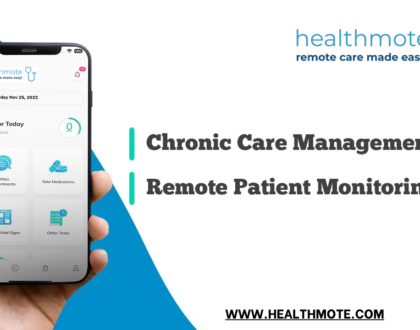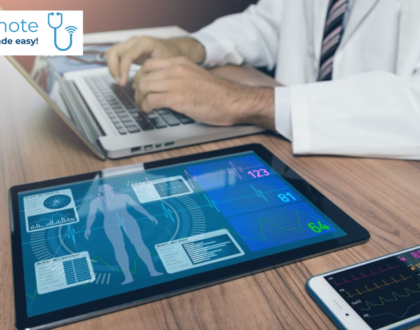
Why Remote Patient Monitoring Is Important To Manage High Blood Pressure
Hypertension is called the silent killer. It can slowly damage the body for years before the patient will start experiencing symptoms. Healthy arteries are strong, flexible, and elastic. Blood can flow freely, supplying organs and tissues with oxygen and nutrients because the inner lining of the arteries is smooth so there is no disruption to the flow of blood.
Hypertension increases the pressure of blood flowing through the arteries and as a result, patients might develop:
- Damaged & Narrow Arteries
- A weakened artery section can cause a section of the wall to bulge (Aneurysm) which can potentially rupture and cause life-threatening internal bleeding.
- When blood can’t flow freely to the heart, it can cause a heart attack.
- When the brain is deprived of oxygen and nutrients, it can cause a stroke.
Millions of patients are diagnosed with Hypertension each year. The risks of uncontrolled hypertension include Stroke, Heart failure, and other cardiac problems, Kidney disease, Vision loss, Sexual Dysfunction, increase risk of severe illness from Covid-19 among others.
The historical method of diagnosing Hypertension:
Traditionally, Blood Pressure Measurement has only been done in clinics. Typically, at every visit, the healthcare provider will use a sphygmomanometer to take blood pressure before the start of the visit. Sometimes, they will also take a measurement at the end of the visit. This provides a very small snapshot of a patient’s blood pressure. When the patient visits the provider’s practice or hospital, a number of things are beyond the control of the healthcare provider and it only provides a point in time measurement. This can be very misleading in the plan of care and diagnosis of hypertension. The patient could be very anxious with all the things going on in practice and it can lead to what is called the white coat syndrome. Sometimes the opposite may happen. The calm and comforting settings of some practices might lead to a patient’s blood pressure being lower than what it normally is during the rest of the day.
The next best way was to have patients take the measurement at home with a Home Blood Pressure Monitoring Cuff and have them write in a book that they can bring during their visits. This method is a step up from the office measurements but does not give the healthcare provider real-time information as well as various ways of analyzing the data. Patients can forget to enter the readings, many times they will write in bits and pieces of paper which are very hard to collate, there is no recording of what happened before the reading was taken. If the patients see high or low readings, there is no one they can turn to for guidance. Sometimes it is a temporary blip because of strenuous exercise or food like coffee, alcohol, etc. and the patient might get panicky.
All of these issues can steer the healthcare provider towards an incorrect line of treatment. There is a risk of over and under medication. If the patient does not really have hypertension and is taking the wrong dosage of medication, that can lead to hypotension in certain conditions which can also be a huge problem. The patient can become dizzy or lose balance leading to increased fall risk. Conversely, if the patient is under-medicated, that can lead to continued harmful effects on the body due to hypertension.
Solution!
What is truly needed is a real-time analysis of the patient’s blood pressure which can give enough data to see the larger trend. You want your patient’s blood pressure to remain in the normal range in the resting position with proper technique day after day in order to mitigate the harmful effects of chronic blood pressure. This is where Healthmote’s Remote Patient Monitoring and care coaches can play a pivotal role in taking good care of your patients and improving their outcomes.
Healthmote provides a turnkey solution that can help your practice enroll, implement and bill for Remote Blood Pressure Monitoring. We integrate with many different types of Blood Pressure machines which include those with a Built-in 4G Cellular Connection that transmits real-time data directly to the provider portal. Geriatric patients do not want to be bothered with smartphones and other such technology which connect to the machine. They want a simple way to take the blood pressure reading and go on with their day. We provide a complete solution where our care coaches will be in constant contact with the patients and guide them every step of the way from un-boxing the devices to showing them how to relax and properly apply the cuff. They will work with the practice staff to create the care plan for the patient and guide the patients between office visits for their proper adherence to the plan.

 Linkedin
Linkedin

